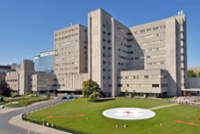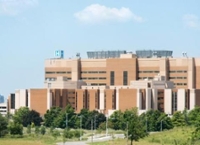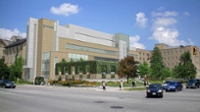Hospital Facilities
The Department of Clinical Neurological Sciences is located on two sites of the London Health Sciences Centre as well as St. Joseph's Health Care London.
University Hospital
University Hospital, located on the London Ontario campus of Western University Canada,  has a 63-bed in-patient, neuroscience unit, which includes the acute stroke monitoring unit (ASMU), the neuro-observation unit, and an 8-bed epilepsy monitoring unit. EMG and EEG labs, the Stroke Prevention Clinic, the Multiple Sclerosis Clinic and the Neuromuscular Clinic are also located at University Hospital.
has a 63-bed in-patient, neuroscience unit, which includes the acute stroke monitoring unit (ASMU), the neuro-observation unit, and an 8-bed epilepsy monitoring unit. EMG and EEG labs, the Stroke Prevention Clinic, the Multiple Sclerosis Clinic and the Neuromuscular Clinic are also located at University Hospital.
The CNS out-patient clinics at University Hospital are comprised of 23 exam rooms, located on the 7th and 10th floors. This space is used in combination with various other disciplines for interviews, counselling, education and treatment planning.
Specialty care in neurology includes epilepsy, movement disorders, the regional stroke program, regional multiple sclerosis clinic, neuro-critical care, amyotrophic lateral sclerosis (ALS) and motor neuron diseases. Neurosurgical care includes cerebrovascular disease, intra-cranial skull-based tumours, brain tumour surgery, spinal surgery and trauma. Neurotology, audiology and cochlear implant programs are also located at University Hospital.
Victoria Hospital
The Children's Hospital of Western Ontario, located at the new Victoria Hospital site, provides comprehensive in-patient and out-patient care for children from birth to age 17.
comprehensive in-patient and out-patient care for children from birth to age 17.
Pediatric neurologists and neurosurgeons have clinical expertise in a variety of areas including epilepsy, cerebral palsy, neurometabolic and neuromuscular disorders, as well as acquired brain injury.
The Urgent Neurology Clinic and the John H. Kreeft Headache Clinic are now located at the Victoria Hospital site.
St Joseph's Health Care London
As a major patient care, teaching and research centre with a distinguished legacy of service to  London, Southwestern Ontario and the veterans of Canada, dating back more than 140 years, St. Joseph’s five key role areas include acute/ambulatory care, complex care and veterans care, long-term care, rehabilitation and specialized geriatrics and specialized mental health care. Facilities and services include St. Joseph’s Hospital, Parkwood Institute, Mount Hope Centre for Long Term Care and the Southwest Centre for Forensic Mental Health Care.
London, Southwestern Ontario and the veterans of Canada, dating back more than 140 years, St. Joseph’s five key role areas include acute/ambulatory care, complex care and veterans care, long-term care, rehabilitation and specialized geriatrics and specialized mental health care. Facilities and services include St. Joseph’s Hospital, Parkwood Institute, Mount Hope Centre for Long Term Care and the Southwest Centre for Forensic Mental Health Care.
Angiograph Suit
The neuroangiography suite holds a bi-plane, digital imaging unit called the "Artis Axiom", manufactured by Siemens. It is used for diagnostic and interventional procedures to image the brain and spine, focusing on the circulation. We generally are looking for pathologies such as aneurysms, AVM's, tumours and other stroke-causing, atherosclerotic disease. We are able to acquire images that are sharper and more defined than ever before, changing parameters and positions with greater ease than in the past.
With the "Leonardo Workstation" we can produce 3D images of blood vessels and isolate areas of interest. Improved visualization allows us to treat these pathologies more confidently.
Operating Room
Nine new, state-of-the-art operating rooms are located at London Health Sciences Centre's University Hospital, including one dedicated to research utilizing robotic technology with fully operative radiology support.
Features:
- One minimally invasive surgery suite equipped with the Zeus™, DaVinci™, Socrates™ and Aesop™ surgical robotic platforms to be used for patient care and research.
- One new transplant room with flat-screen video technology that will enable minimally invasive surgery.
- Two new orthopaedic rooms featuring laminar flow technology, which reduces the risk of infection.
- One new orthopaedic room dedicated to sports medicine, featuring state-of-the-art video technology.
- Three new neurosurgery rooms, including one for use with angiography and radiology; one that is copper-shielded from radio frequency interference to permit deep-brain stimulation surgery for patients with epilepsy and other neurological disorders; and one for general use, including urology.
Specialized Procecedures
- Stereotactic neurosurgery: Computer-assisted guidance in brain surgery that allows the placement of biopsy tools or electrodes deep in the brain.
- Surgical Navigation: The use of computers to plan precise approaches to areas of the brain during surgery.
- Cavitron: Surgical device that disintegrates and aspirates brain tumors.
- Intraoperative Angiography: The use of blood vessel x-rays during surgery to enhance outcomes for aneurysms or arteriovenous malformation surgery.
- Cortical mapping EE: Provides the surgeon with information on where essential functions are located in the brain, so the surgeon will avoid cutting through these areas; identifies the area of the brain causing seizures.
- Artificial disc replacement spinal surgery: Unlike traditional spinal fusion surgery, where the movement of a degenerated disc is stopped by fusing the surrounding vertebrae together, this new procedure replaces the bad disc with an artificial one. The discs come in different sizes to fit a patient's anatomy, and are designed to allow patients to replicate natural movement.
- Cerebrovascular Surgery
- Carotid Atherosclerosis Surgery
- Intracranial Skull Base Tumors
- Trigeminal Neuralgia
- Epilepsy Surgery
- Spinal Surgery
- Intracranial Tumors- Adult and Paediatric
- CNS Trauma: Brain, Head, Spine
- Stereotactic Radiosurgery: Tumors, Arteriovenous Malformations
- Stereotactic Surgery: Tumors, Movement, Pain
- Paediatric Neurosurgery
- Functional Neurosurgery








